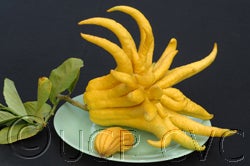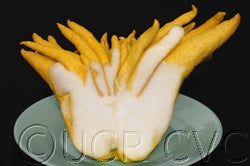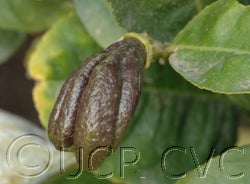Fingered citron
Citrus medica L.
Citrus medica var. sarcodactylis (Hoola van Nooten) Swingle
CRC 3768
PI 539445
VI 369
Source
Budwood import from Hawaii, via CCPP, 1975. Exocortis removed by shoot tip grafting.
Parentage/origins
Parents unknown.
Rootstocks of accession
Yuma Ponderosa lemon and citremon.
Main season of ripeness at Riverside
November to January. Some yellow fruits appear year-round.
Description and use (OJB and DK)
The tree is small and shrubby with an open habit. It is very frost-sensitive. Citron leaves are distinctive in form, being oblong and somewhat rumpled, with serrate margins. The flowers and new leaves are heavily tinged with purple. The very small immature fruits may also be flushed with purple, so that they appear almost brown. The 6- to 12-inch fruits split longitudinally at the end opposite the stem, as the carpels separate into segments that look somewhat like human fingers. The rind is yellow and highly fragrant at maturity, with a characteristic aroma of violets or osmanthus, largely derived from a compound called beta-ionone (Shiota, 1990). The interior of the fruit is solid albedo (the white part of the skin) with no juicy pulp or seeds.Buddha’s Hand citron fruits usually mature in late fall to early winter and hold moderately well on the tree, but not as well as other citron varieties.
In China the Buddha’s Hand citron symbolizes happiness and long life, because its name, “fo-shou”, has those meanings when written with other characters. Chinese like to carry the fruit in their hands, place it on tables in their homes, and present it as a sacrificial offering at temple altars. Though esteemed chiefly for its exquisite form and aroma, the Buddha’s Hand fruit is also eaten in desserts and savory dishes, and the sliced, dried peel of immature fruits is prescribed as a tonic in traditional medicine. The tree is very popular as an ornamental, often in bonsai form, in pots. The Buddha’s Hand was important by the 10th century A.D. in Fujian. Chinese artists classically depicted the fruit in jade and ivory carvings, in prints, and on lacquered wood panels (Simoons, 1991).
In Japan the “bushukan,” as the Buddha’s Hand citron is called, is a popular gift at New Year’s, for it is believed to bestow good fortune on a household. The Japanese buy the fruit at decorative ornament shops, and place it on top of specially pounded rice cakes, or use it in lieu of flowers in the home’s sacred tokonoma alcove (Elizabeth Andoh, pers. comm., 1997).
Taxonomy and nomenclature (DK)
Although the Buddha’s Hand tree bears fruits that are different from other citrons in shape, it is otherwise a typical member of the species. It is usually considered as one variety in the United States, but in China there are actually at least a dozen named Buddha’s Hand varieties or subvarieties, differing in fruit shape, color and size, and the tree’s growing habit, etc. These varieties are classed in several types grown for specific purposes, such as fruit production or bonsai tree sales (Guo, 1993; Chen, 2002; Chen, 2003; Zhang, 2007).
In Yunnan a variety called “Muli” or “Xiangyanggo” has fruit characteristics intermediate between the common and the Buddha’s Hand citron (Wang, 1983; Gmitter, 1990). Along the same lines, Hodgson (see below) writes that in one clone “only part of the fruits are fingered and the rest are corrugated, lacking in flesh, and contain seeds hanging free in the locules.” There also exists a variegated form. Clearly the CVC accession (CRC 3768) is a standard Buddha’s Hand (no pulp, no seeds, no variegation), but its particular variety or subvariety has not yet been determined.
“Buddha’s Hand citron” and “Fingered citron” are alternative names for the same variety or group of varieties. In China, where numerous scientific studies of the Buddha’s Hand citron have been published, its Chinese name is often mistranslated into English as “bergamot,” which properly refers to C. bergamia (this true bergamot, another aromatic citrus, is a natural hybrid of sour orange and limetta [C. aurantium x C. limetta]).
Cultivation of Buddha’s Hand citrons in China and California (DK)
In China, the Buddha’s Hand citron “has long been cultivated in Weishang county, western Yunnan, at elevations up to 1500 m” (Gmitter, 1990). Currently the Chinese grow some 2,000 hectares (5,000 acres) of Buddha’s Hand citron, mostly in the Jinhua district of Zhejiang province, south of Shanghai (Xiuxin Deng, pers. comm., 2007).
A treatise on citrus from the late 19th century (Lelong, 1888) mentioned that the Buddha’s Hand citron had been introduced to California from Japan, but for about a century thereafter the tree was rarely grown in the state, and only as a curiosity in private gardens. In the early 1980s virtually no commercial plantings of Buddha’s Hand existed in California, but as of 2008 there were at least 10 hectares (25 acres) farmed by specialty citrus growers. The fruit is sold at Asian markets, upscale supermarkets and farmers markets, from California to the East Coast, mostly for its unusual looks and exquisite fragrance. It is also used for flavoring savory dishes, desserts and alcoholic beverages (such as vodka), and for making preserves.
Budwood of this accession is available through the Citrus Clonal Protection Program. Many nurseries sell Buddha’s Hand trees, which are quite popular in home gardens.
The trees are very cold-sensitive, and require an almost completely frost-free location. For commercial growers, packing and postharvest practices are tricky, because the fruits can’t be processed on a standard packing line, need to be cleaned and buffed by hand, and tend to develop mold quickly.
Description by Water T. Swingle and Phillip C. Reese in “The Botany of Citrus and Its Wild Relatives,” in The Citrus Industry, Volume 1, Chapter 3, p. 372
Citrus medica var. sarcodactylis (Noot.) Swing. Pl. Wilson. 2:141. 1914. Citrus sarcodactylis Noot. Fleurs, Fruits, Feuill. Java 1:pl. 3. 1863. Illus. Nooten, loc. cit., pl. 3; Swingle, in Bailey, Stand. Cycl. Hort. 1:781. 1914.
Type.—Lacking in Linnean Herbarium.
Distribution.—Widely cultivated in China, Japan, Indo-China, and India.
Common name.—Fingered citron.
Like the species except in the fruit, which is split into a number of finger-like sections. Usually pulp is lacking, or if present is very scanty.
The fingered citron is well known and highly esteemed for its fragrance and beauty in China and Japan, where it is called “Buddha's Hand Citron” (Fo Shou kan in Chinese, Bushu-kan in Japanese). It is used by Chinese and Japanese for perfuming rooms and clothing. It is also grown as a dwarf plant, of which good fruiting specimens are highly prized for ornamental purposes.
Description by R. W. Hodgson in “Horticultural Varieties of Citrus” in The Citrus Industry, Volume 1, Chapter 4, p. 556: A most unusual and interesting citron is the fingered or Buddha’s Hand citron (fig. 4-71) of the Orient (bushukan of Japan), where it has been prized for centuries, especially in Indo-China, China and Japan. As the name indicates, the fruit is apically split into a number of fingerlike sections, somewhat resembling a human hand. There appear to be two clones—one in which all the fruits are deeply fingered and lacking in flesh development and seeds, the other in which only part of the fruits are fingered and the rest are corrugated, lacking in flesh, and contain seeds hanging free in the locules. Both are typical acid citrons in all other respects and would seem to constitute clonal varieties rather than the botanical variety sarcodactylis as they are classified by Swingle (see chap. 3, p. 372).
Availability
Commercially available in California through the Citrus Clonal Protection Program. Click here to order budwood.
USDA Germplasm Resources Information Network page for Buddha’s Hand citron
Buddha’s Hand citron bibliography (DK)
Bonavia, E. 1888-90. The Cultivated Oranges and Lemons of India and Ceylon. London, W. H. Allen.
Chen, Bing-Chu, Tie-Qiao Zhao, Bo-Jun Ma, Chun-Rong Shao. 2002. Type delimitation and RAPD analysis of Jinhua fingered citron (Circodactylitrus medica var. sarcodactylis Swingle). Journal of Fruit Science 19(4):278-280 (in Chinese).
Chen, Bing-Chu, Wen-Yue Shentu. 2003. Compared on biological characteristics in 3 types of Jinhua fingered citron. Forest Research, Beijing 16(6):774-776 (in Chinese).
Du, Yue-Qiang. 2002. Standardizing production and industrialized development countermeasures of Citrus medica var. sarcodactylis. Journal of Zhejiang Forestry Science and Technology 22(2):68-70 (in Chinese).
Gao, Xiao-Xia, Xiao-Ying Chen, Yuan-Sheng Luo. 2007. Preliminary study on rDNA ITS sequencing and characteristics of Citrus medics L. var. sarcodactylis (Noot.) Swingle. Zhong Yao Cai 30(3):268-70 (in Chinese).
Gmitter, Frederick G., Jr. and Xulan Hu. 1990. The possible role of Yunnan, China, in the origin of contemporary citrus species (Rutaceae). Economic Botany 44(2):267-277.
Hodgson, Robert W. 1967. “Horticultural varieties of citrus,” in W. Reuther, H.J. Webber, and L.D. Batchelor (eds.). The citrus industry, vol. 1. Univ. Calif., Berkeley.
Huang, XiaoYu, XiuYin Zhong, Yi Su. 1998. Extraction and identification of volatile oil in fingered citron. Journal of South China Agricultural University 19(3):101-106 (in Chinese).
Lin, Zongxue. 2006. Reproductive characters and cultivation techniques of Citrus medica var. Sarcodactylis. Bulletin of Agricultural Science and Technology 3 (in Chinese).
Lu, Long-Gao, JinLin Wu. 2006. The cultural techniques for raising potted plant of Jinhua bergamot. South China Fruits (No.1):16-17 (in Chinese).
Ma, Bo-Jun, Bin-Yi Zhang, Biao Chen, and Bing-Chu. 2002. RAPD analysis of genetic polymorphism and molecular identification of Citrus medica cv. sarcodactylis from Jinhua. Zhongcaoyào 33(5)460-462 (in Chinese).
Saunt, James. 2000. Citrus varieties of the world. 2nd ed. Sinclair International, Norwich, UK.
Shiota, H. 1990. Volatile components in the peel oil from fingered citron (Citrus medica L. var. sarcodactylis Swingle). Flavour and Fragrance Journal 5(1):33-37.
Simoons, Frederick J. 1991. Food in China: a cultural and historical inquiry. CRC, Boca Raton.
Swingle, Water T. and Phillip C. Reese. 1967. “The botany of citrus and its wild relatives,” in W. Reuther, H.J. Webber, and L.D. Batchelor (eds.). The citrus industry, vol. 1. Univ. Calif., Berkeley.
Tkatchenko, Boris. 1938. Le cédrat en Cochinchine. Bulletin économique de l'Indo-chine, 41-46:1389-1413.
Tolkowsky, Samuel. 1938. Hesperides: a history of the culture and use of citrus fruits. John Bale, Sons and Curnow, London.
Wang, H. K., Y. X. Ding, S. J. Yang. 1983. Muli citron – a variety of Citrus medica L. Acta Horticulturae Sinica 10(3):181-182 (in Chinese).
Wang, Qiong, Cai-Juan Chen, Xiao Shi, Li-Shan Xu, Xiao-Ling Jin. 2002. Comparative studies on volatile oils in fruits of four varities [sic] Citrus medica var. sarcodactylis. China Pharmaceutical magazine (in Chinese).
Wang, Bin, Wei Zheng. 2004. The cultural techniques for pot-grown fushou, a cultivar of Citrus medica. South China Fruits 33(2):13-14 (in Chinese).
Wu HaiPo, ZhiJie Huang. 2001. Fingered citron, a valuable medicinal and ornamental citrus species. South China Fruits 30(1):21 (in Chinese).
Zhang, Gui-Fang, Hong-Hua Xu. 2007. Bergamot germplasm resources research overview. Journal of Guangzhou University of Traditional Chinese Medicine (in Chinese).
Zhang, Xing-Wang. 2003. The use of fushou and its cultural techniques. South China Fruits 32(2):7-8 (in Chinese).
Zhou, Chun-Li, Wei-Dong Guo. 2005. Current studies on the plasm of Citrus medica L. var. sarcodactylis 3:89-110 (in Chinese).
Zhou, Chun-Li, Wei-Dong Guo, Mei Lu, Jin Chen, and Yu-Ping Li. 2006. Factors effecting the transformation of Citrus medica L. var. sarcodactlis mediated by agrobacterium. Journal of Tropical and Subtropical Botany 14(5):374-381 (in Chinese).





